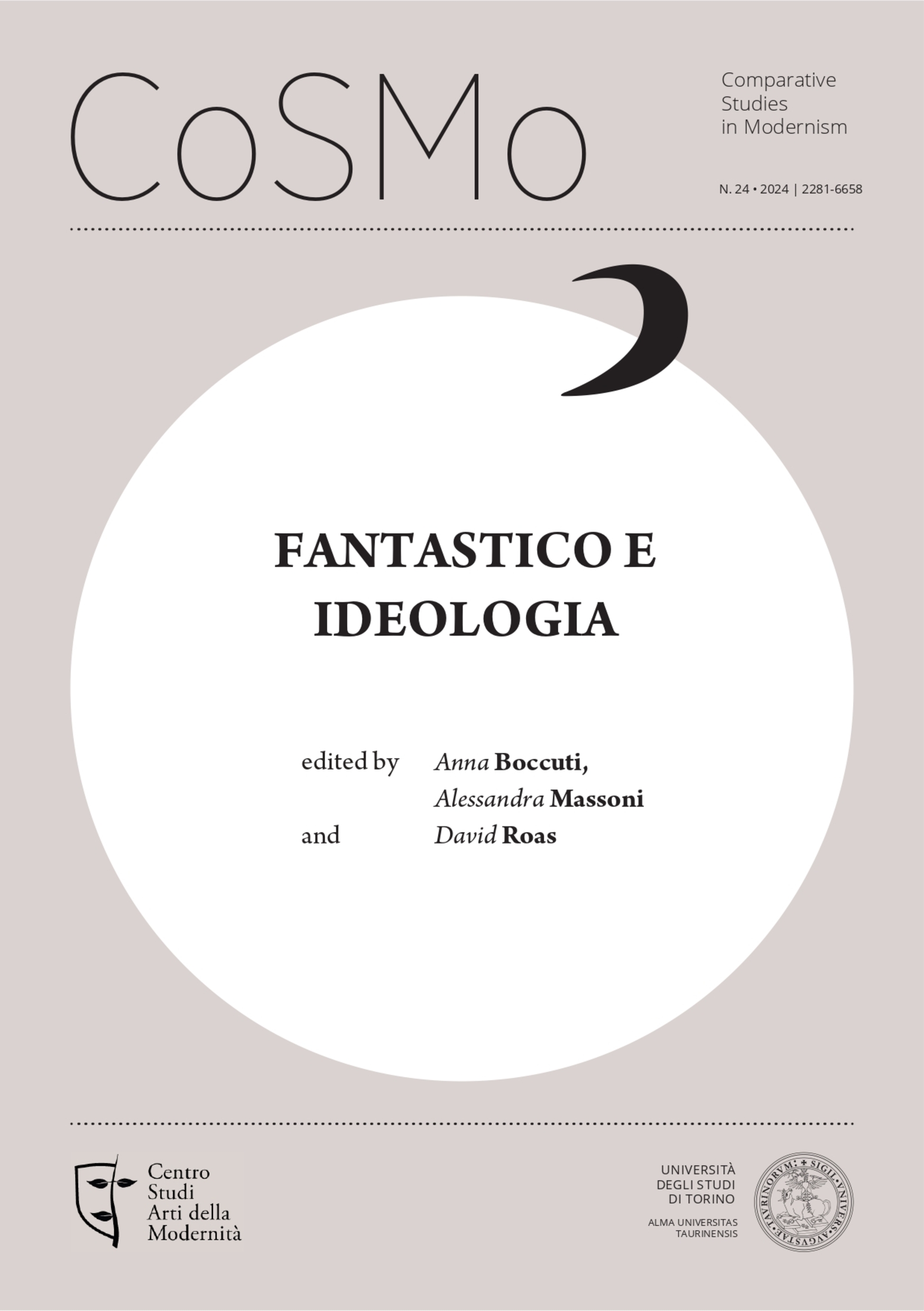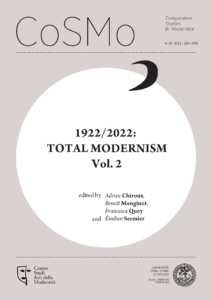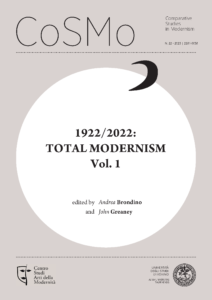CALL FOR PAPERS “Rinascimento modernista. Le sopravvivenze del Rinascimento italiano nella letteratura europea tra Otto- e Novecento”
A cura di Pablo Maurette, Alessandro Metlica, Valentina Monateri
CoSMo: Comparative Studies in Modernism (uscita prevista dicembre 2026)
Invito a contribuire
Deadline: 15 settembre 2025
English version follows.

Rinascimento modernista.
Le sopravvivenze del Rinascimento italiano nella letteratura europea tra Otto e Novecento
Nella seconda metà degli anni Venti del Novecento, via via che si definisce il cantiere del Mnemosyne Atlas, Aby Warburg vara una nuova ermeneutica per la storia della cultura (Centanni 2022, Freedberg e Wedepohl 2024). Priva del carattere lineare che gli aveva assegnato il positivismo, né uniforme né omogenea, perché segnata invece da un moto franto, ondivago e intermittente, la memoria collettiva si rivela soggetta a sbalzi di tensione: le sue latenze e i suoi picchi emozionali vanno interrogati, perciò, con dispositivi oscillatori simili al pendolo (Didi-Huberman 2002).
Questa ermeneutica ha il suo baricentro nel Rinascimento italiano, oggetto privilegiato degli studi di Warburg. Si tratta, tuttavia, di un Rinascimento affatto inedito, sghembo e fantasmatico (Centanni 2017), che si dimostra capace, in quanto tale, di riattivare le preconiazioni dell’arte greco-romana e di risignificare il contemporaneo, dal Déjeuner sur l’herbe di Manet alla fotografia di una campagnola di Settignano: un Rinascimento anacronico (Didi-Huberman 2000, Nagel e Wood 2024) che rompe in maniera netta con i modelli della saggistica precedente e coeva, dal raffinato soggettivismo di Walter Pater, improntato al culto della percezione e del temperamento, al gusto estetizzante di Bernard Berenson. Warburg guarda invece alla Civiltà del Rinascimento in Italia di Jacob Burckhardt (Ghelardi 2023), di cui già Friedrich Nietzsche aveva offerto una versione esacerbata, per così dire a tinte forti (Farulli 1998, Milella 2000): “sismografi sensibilissimi” dei movimenti tettonici della cultura europea (Warburg 1927), Burckhardt e Nietzsche ispirano una nuova concezione del Rinascimento italiano, che però soltanto nelle tavole dell’Atlante – dove date e luoghi sono apertamente sovvertiti, così da tracciare itinerari di conoscenza insospettati – si scopre risolutamente moderna.
Questa sezione “Focus” di CoSMo: Comparative Studies in Modernism si chiede se il Rinascimento scoperto da Warburg, oltre che moderno, possa dirsi modernista. L’obiettivo è infatti indagare le ripercussioni, le reinterpretazioni e più in generale i punti di contatto della temperie-Mnemosyne con il modernismo letterario europeo. Posto che, tra gli anni Venti e Trenta del Novecento, l’Atlante non cade subito nella dimenticanza, come erroneamente si è creduto a lungo, e che viceversa, sia pure sul breve periodo, il progetto si presenta come un’opera compatta, coerente e prossima alla stampa (Zanon 2024), non si tratterà di circoscrivere le influenze e i debiti puntuali tra Mnemosyne e gli scrittori modernisti. In linea, piuttosto, con quanto è stato fatto per Shakespeare e la letteratura inglese early modern (Matthews 2013, Goldberg 2022), ci si propone una prima mappatura delle citazioni che, nel romanzo, nella novella e nel teatro modernisti, rimandano al Rinascimento italiano, con lo scopo di analizzare le formule di questa rievocazione e di verificare se, sul piano figurale e stilistico, la pagina letteraria assuma i tratti anacronici e fantasmatici teorizzati dall’Atlante.
Un catalogo degli autori coinvolti, lungi dall’essere esaustivo, include Gabriele D’Annunzio, Le vergini delle rocce, Il fuoco, Forse che sì forse che no; Heinrich Mann, la novella Das Wunderbare, Die Göttinnen, Pippo Spano; Thomas Mann, Glaudius Dei, Fiorenza; Hugo von Hofmannsthal, Ein Brief, Der Tod des Tizian; Der Turm; Virginia Woolf, Orlando; Henry James, Portrait of a Lady, The Aspern Papers; Ezra Pound, The Cantos; Paul Valéry, Introduction à la méthode de Léonard de Vinci; Marcel Proust, À la recherche du temps perdu.
Il “Focus” verrà analizzato lungo quattro principali linee di ricerca:
- Analizzando le rappresentazioni letterarie del Quattro e del Cinquecento italiano, che si infittiscono nella letteratura europea sin dagli ultimi anni dell’Ottocento, a valle della predilezione romantica per il gotico e per il Medioevo, questo “Focus” di CoSMo intende esaminare in prospettiva warburghiana fenomeni retorici e diegetici come la rifunzionalizzazione dell’ornamento (Vandi 2017), la dialettica tra stasi e movimento, le nuove tecniche di montaggio narrativo (Michaud 1998) e la scomposizione della linearità temporale.
- La simultaneità polifocale del romanzo modernista, tesa a rimpiazzare la direzionalità orientata del discorso, si muove di concerto con il modello stratificato ma aperto, costituzionalmente in divenire, delle tavole dell’Atlante? La diffusione di temi e personaggi tratti dal Rinascimento italiano ha un ruolo in questo fenomeno, ne marca alcuni snodi significativi o, al contrario, si ispira al paradigma raffinatissimo, ma più rassicurante e tradizionale, di Pater o di Berenson? Quanto è influente al di fuori del contesto tedesco la “critica” del Rinascimento mossa da Thomas Mann in Betrachtungen eines Unpolitischen (1918), e già parzialmente presentata nel dramma Fiorenza (1905)?
- In prospettiva inter artes (Ritter Santini 1986), il fatto che il fine secolo e il modernismo riscoprano la storia come modello ne determina anche le possibilità di trasgressione e adattamento. Alle forme di esotismo nello spazio, tipiche del tournant de siècle, si accompagnino infatti forme di esotismo nel tempo (Ritter Santini 1994) che sembrano prediligere – specialmente nel contesto tedesco, ma non solo – il Rinascimento italiano inteso come culla della “civiltà” politica, sociale e artistica. In questi termini, la diffusione del fenomeno del Renaissancismus in Europa non corrisponde soltanto a una «deformazione letteraria della storia», ma anche a una «riscoperta del grande stile» e, di conseguenza, dello stile italiano (L. Ritter Santini, 1986: 61).
- In determinati casi, le letterature moderniste sembrano procedere alla maniera dell’arte rinascimentale italiana, esaltando forme di corrispondenza che trovano un esito felice soprattutto nel dialogo interartistico. Il “Focus” di questo numero di CoSMo tenta allora di ampliare l’orizzonte di studi rispetto alla ripresa novecentesca del Barocco. Al di là dell’enorme risonanza critica generata dallo studio di Walter Benjamin sul Trauerspiel, questo numero tenta di delineare il volto rinascimentale dei modernismi euroamericani. Le letterature moderniste diluiscono i confini storici, costruendo una narrativa del rapporto Riforma/Controriforma spesso letta sotto l’egida dell’arte di Dürer e Michelangelo. Figure centrali della storia della prima modernità europea riemergono in forme a volte “ossessive”—basti pensare al Giordano Bruno di Joyce, Mann e, infine, dello stesso Warburg che nel 1928 invita Leonardo Olschki a tenere una lezione ad Amburgo sul filosofo di Nola.
Possibili temi di ricerca:
Di modernismo, in questa sede, si dà un’accezione ampia in senso sia geografico che cronologico (Lewis 2011). Il corpus preso in esame comprende tutte le lingue e le letterature euroamericane, e spazia dagli ultimi anni dell’Ottocento alla Seconda Guerra Mondiale comprendendo figure non canoniche ed eccentriche. Tra gli altri, possibili spunti tematici sono: la supposta nascita del genio “moderno”, tormentato e universale, a partire da figure archetipiche come Leonardo e Michelangelo (Bredekamp 2021); la natura passionale e anzi la famigerata vitalità dionisiaca del Meridione; l’ostentato preziosismo di certa industria culturale, che nei tessuti, nei gioielli e nei pezzi di mobilio, oltre che nelle copie-feticcio dei dipinti dei maestri quattro e cinquecenteschi, pretende di ispirarsi all’Italia delle Signorie.
Bibliografia
- Lorella Bosco e Helmut Koopmann, Thomas Mann e l’Italia in una nuova prospettiva, in «Belfagor», 60-4, 2005, pp. 373-392
- Horst Bredekamp, Michelangelo, Berlino, Wagenbach, 2021
- Jacob Burckhardt, Il Rinascimento italiano. Civiltà e arte [1860], Torino, Einaudi, 2023
- Monica Centanni, Fantasmi dell’antico. La tradizione classica nel Rinascimento, Rimini, Guaraldi, 2017
- Monica Centanni, Warbug and Living Thought, Vicenza, Ronzani, 2022
- Fabio Della Schiava, D’Annunzio e il Rinascimento, «Aevum», 92-3, 2018, pp. 603-624
- Luca Farulli, Burckhardt e Nietzsche, Firenze, Polistampa, 1998
- Georges Didi-Huberman, Devant le Temps. Histoire de l’art et anachronisme des images, Parigi, Les Editions de Minuit, 2000.
- Georges Didi-Huberman, L’Image survivante. Histoire de l’art et temps des fantômes selon Aby Warburg, Parigi, Les Editions de Minuit, 2002.
- David Freedberg e Caudia Wedepohl (a cura di), Aby Warburg: Work, Legacy, Promise, Berlino, De Gruyter, 2024
- Elisabeth Galvan (a cura di), Heinrich e Thomas Mann. Un confronto con il romanzo moderno, Istituto Italiano di Studi Germanici, 2012
- Maurizio Ghelardi, La modernità di un antimoderno, in Dürer, Rembrandt, Manet. Warburg Manebit!, «La Rivista di Engramma», 206, 2023, pp. 275-288
- Jonathan Goldberg, Being of Two Minds: Modernist Literary Criticism and Early Modern Texts, Fordham University Press, 2022
- Pericles Lewis (a cura di), The Cambridge Companion to European Modernism, Cambridge University Press, 2011
- Steven Matthews, T.S. Eliot and Early Modern Literature, Oxford University Press, 2013
- Philippe-Alain Michaud, Aby Warburg et l’image en mouvement, Macula, 1998
- Alexander Nagel e Christopher S. Wood, Anachronic Renaissance, New York, Zone Books, 2010
- Francesca Puccini, La “virtù” dell’uomo del Rinascimento. Nietzsche e Gebhart, in La trama del testo. Su alcune letture di Nietzsche, Lecce, Milella, 2000
- Lea Ritter Santini, Le immagini incrociate, Il Mulino, Bologna, 1986
- Lea Ritter Santini, Ritratti con le parole, Il Mulino, Bologna 1994
- Martin A. Ruehl, The Italian Renaissance in the German Historical Imagination, 1860-1930, Cambridge, Cambridge University Press, 2015
- Leon Surette, Demetres P. Tryphonopoulos (a cura di), Literary Modernism and the Occult Tradition, Orono, University of Maine, 1996
- Loretta Vandi (a cura di), Ornament and European Modernism: From Art Practice to Art History, Routledge, 2017
- Frances Yates, Giordano Bruno and the Hermetic Tradition, Chicago-London, University of Chicago press, 1964
- Frances Yates, Astrea: the Imperial Theme of the Sixteenth Sentury, London-Boston, Routledge & Kegan, 1975
- Giulia Zanon, “Portiamo il peso di un’eredità ambigua”. Una storia dell’Atlante Mnemosyne di Aby Warburg 1924-1945, tesi di dottorato, a.a. 2024-2025, IUAV, Venezia.
- Aby Warburg, Burckhardt e Nietzsche [1927], in M. Ghelardi, Jacob Burckhardt, Friedrich W. Nietzsche, Carteggio, Torino, Aragno, 2002.
Call for papers
Le proposte di intervento, un abstract di max. 1500 battute e una breve nota biografica, dovranno pervenire a centrostudiartimodernita@gmail.com entro il 15 settembre 2025. L’accettazione o meno della proposta verrà comunicata entro il 30 settembre 2025. Il termine per la consegna del contributo, di max. 30.000 battute, è il 30 marzo 2026.

CoSMo: Comparative Studies in Modernism (expected release: December 2026)
Call for papers
Modernist Renaissance.
Italian Renaissance Afterlife in Nineteenth and Twentieth Century Euro-American Literatures
Edited by Pablo Maurette, Alessandro Metlica, Valentina Monateri
In the first half of the Twentieth century, as the Atlas Mnemosyne project was on its way, Aby Warburg pioneered a new hermeneutics for cultural history (Centanni 2022, Freedberg and Wedepohl 2024). Lacking the linear perspective Positivism had assigned to it, neither uniform nor homogeneous, Warburg’s sense of Collective Memory is fractured, waving, constantly shifting, and marked by sudden, abrupt tensions. This is the reason why its emotional peaks and its latencies must be interrogated with oscillatory instruments like the pendulum (Didi-Huberman 2002).
This Warburgian hermeneutics had its center of gravity in the Italian Renaissance, the favoured subject of Warburg’s research. Though not at all entirely new, Warburg’s Renaissance is oblique, phantasmagorical, and proves capable, as such, of reactivating the figurative anticipations of Greco-Roman art, as well as re-signifying the contemporary, from Manet’s Déjeuner sur l’herbe to the photograph of a Settignano countrywoman. It is an anachronic Renaissance (Didi-Huberman 2000, Nagel and Wood 2024) that breaks with its 19th century models, from Walter Pater’s refined subjectivism, marked by the cult of perception and temperament, to Bernard Berenson’s aesthetic taste.
On the contrary, alternatively, Warburg was deeply impressed by Jacob Burckhardt’s The Civilization of the Renaissance in Italy (Ghelardi 2023), of which Friederich Nietzsche had already offered an intensified reading—a “hard” one, so to speak (Farulli 1998, Milella 2000). As “sensitive seismographers” of the tectonic movements of European culture (Warburg 1927), Burckhardt and Nietzsche inspired new views of the Italian Renaissance, which only in the Atlas tables – where dates and places are openly subverted, as to open new routes for knowledge – is revealed as resolutely modern.
This 2025 “Focus” of CoSMo: Comparative Studies in Modernism then poses a question: can we call Warburg’s Renaissance modernist, as well as we call it modern? Indeed, the aim of this Focus is to investigate the legacies, the interpretations and the contacts between the Mnemosyne-atmosphere and the Euro-American literary modernism. That said, between the 1920s and 1930s, the Atlas did not immediately fall into oblivion, as was mistakenly believed for a long time, and also, albeit in the short term, the project presented itself as a compact, coherent work that was close to printing (Zanon 2024). Following this lead, it will not only be a matter of listing the influences and punctual debts between Mnemosyne and modernist writers, but rather, in line with what has been done with Shakespeare and early modern English literature (Matthews 2013, Goldberg 2022), this proposal points to possible, first mappings of quotations, intertexts, formulas and references that, in the modernist novel, novella and theatre, refer back to the Italian Renaissance. The aim of this analysis is to verify whether, on a figural and stylistic level, the literary page takes on the anachronistic and phantasmal traits presented in the Atlas.
Far from being exhaustive, a list of authors and works involved are Gabriele D’Annunzio’s Le vergini delle rocce, Il fuoco, Forse che sì forse che no; Heinrich Mann’s Das Wunderbare, Die Göttinnen, Pippo Spano; Thomas Mann’s Glaudius Dei, Fiorenza; Hugo von Hofmannsthal’s Ein Brief, Der Tod des Tizian; Der Turm; Virginia Woolf’s Orlando; Henry James’ Portrait of a Lady, The Aspern Papers; Ezra Pound’s The Cantos; Paul Valéry’s Introduction à la méthode de Léonard de Vinci; Marcel Proust’s À la recherche du temps perdu.
Thus, the issue will be investigated along four main cores:
1. Studying works dedicated to the representations of 15th– and 16th-century Italy, which became more and more popular in European literature since the last decades of the 19th century in contrast with the Romantic taste for Medieval and Gothic settings, this CoSMo issue will examine rhetorical and diegetic phenomena in a Warburgian perspective. Examples of which are the re-functionalisation of ornamental writing (Vandi 2017), the dialectic between stasis and movement, new techniques of narrative montage (Michaud 1998) and the breakdown of temporal linearity.
2. Does the polyfocal simultaneity of modernist novels, meant to replace the linear course of writing, go in the same direction as the layered but open-ended, in-progress model of the Atlas tables? Does the dissemination of themes and characters drawn from the Italian Renaissance play a role in this new Renaissance ‘facet’, does it mark some significant junctures or, on the contrary, is it inspired by the refined, but more reassuring, traditional paradigm of Pater or Berenson? Lastly, how influential, outside of the German context, is the ‘critique’ of the Renaissance made by Thomas Mann in Betrachtungen eines Unpolitischen (1918), and already partially discussed in Mann’s play Fiorenza (1905)?
3. From an inter artes critical perspective (Ritter Santini 1986), the fact that at the turn of the century History is rediscovered as a model for living also enables fin-de-siècle and modernist practices to experiment in transgression and adaptation. At the turn of the century, typical forms of exoticism in space are accompanied by forms of exoticism in time (Ritter Santini 1994), which seem to favour – especially, but not only, in the German context – the metaphor of the Italian Renaissance as the cradle of political, social and artistic ‘civilisation’. Seen in this perspective, the spread of the phenomenon of Renaissancismus in Europe does not only correspond to a literary deformation of history, but also to a rediscovery of Italian “grand style” (L. Ritter Santini, 1986: 61).
4. Modernist literatures seem to proceed alla maniera of Italian Renaissance art, exalting forms of correspondences that find happy solutions above all in the inter-artistic dialogue. This Cosmo issue will try to investigate possible connections between modernist forms and genres and the twentieth-century revival of Baroque. In addition to and beyond the huge critical resonance of Walter Benjamin’s study on Trauerspiel, this issue will insist on the Renaissance flair of Euro-American modernism. One can maintain that modernist literatures reduce historical boundaries, reading the relationship Reformation/Counter-Reformation in the light of Dürer and Michelangelo’s production. Central figures in the history of early European modernity re-emerge in ‘obsessive’ terms—suffice it to think of Joyce’s and Mann’s Giordano Bruno, or, finally, of Warburg himself, who in 1928 invited Leonardo Olschki to give a lecture in Hamburg on the philosopher from Nola.
Possible themes among others:
In this call we apply a broad meaning of ‘Modernism’, in both a geographical and chronological sense (Lewis 2011). The corpus examined includes all Euro-American languages and literatures, and ranges from the last years of the 19th century to the Second World War including non-canonical and excentric figures. Among others, possible themes are: the birth of the “modern” genius from archetypal figures such as Leonardo and Michelangelo (Bredekamp 2021); the “passionate” nature and the Dionysian vitality of the South; the cultural industry that from textiles, jewelry and furniture, to the fetish-copies of 15th and 16th masters and paintings, claim to be inspired by the epoch of the Italian Signorie.
References
- Bosco, Lorella, e Helmut Koopmann. “Thomas Mann e l’Italia in una nuova prospettiva.” Belfagor 60, n. 4 (2005): 373–392.
- Bredekamp, Horst. Michelangelo. Berlino: Wagenbach, 2021.
- Burckhardt, Jacob. Il Rinascimento italiano. Civiltà e arte [1860]. Torino: Einaudi, 2023.
- Centanni, Monica. Fantasmi dell’antico. La tradizione classica nel Rinascimento. Rimini: Guaraldi, 2017.
- —. Warburg and Living Thought. Vicenza: Ronzani, 2022.
- Della Schiava, Fabio. “D’Annunzio e il Rinascimento.” Aevum 92, n. 3 (2018): 603–624.
- Farulli, Luca. Burckhardt e Nietzsche. Firenze: Polistampa, 1998.
- Didi-Huberman, Georges. Devant le Temps. Histoire de l’art et anachronisme des images. Parigi: Les Éditions de Minuit, 2000.
- —. L’Image survivante. Histoire de l’art et temps des fantômes selon Aby Warburg. Parigi: Les Éditions de Minuit, 2002.
- Freedberg, David, e Claudia Wedepohl, a cura di. Aby Warburg: Work, Legacy, Promise. Berlino: De Gruyter, 2024.
- Galvan, Elisabeth, a cura di. Heinrich e Thomas Mann. Un confronto con il romanzo moderno. Roma: Istituto Italiano di Studi Germanici, 2012.
- Ghelardi, Maurizio. “La modernità di un antimoderno.” In Dürer, Rembrandt, Manet. Warburg Manebit!, La Rivista di Engramma 206 (2023): 275–288.
- Goldberg, Jonathan. Being of Two Minds: Modernist Literary Criticism and Early Modern Texts. New York: Fordham University Press, 2022.
- Lewis, Pericles, a cura di. The Cambridge Companion to European Modernism. Cambridge: Cambridge University Press, 2011.
- Matthews, Steven. T.S. Eliot and Early Modern Literature. Oxford: Oxford University Press, 2013.
- Michaud, Philippe-Alain. Aby Warburg et l’image en mouvement. Parigi: Macula, 1998.
- Nagel, Alexander, e Christopher S. Wood. Anachronic Renaissance. New York: Zone Books, 2010.
- Puccini, Francesca. “La ‘virtù’ dell’uomo del Rinascimento. Nietzsche e Gebhart.” In La trama del testo. Su alcune letture di Nietzsche, 93–112. Lecce: Milella, 2000.
- Ritter Santini, Lea. Le immagini incrociate. Bologna: Il Mulino, 1986.
- —. Ritratti con le parole. Bologna: Il Mulino, 1994.
- Ruehl, Martin A. The Italian Renaissance in the German Historical Imagination, 1860–1930. Cambridge: Cambridge University Press, 2015.
- Surette, Leon, e Demetres P. Tryphonopoulos, a cura di. Literary Modernism and the Occult Tradition. Orono: University of Maine, 1996.
- Vandi, Loretta, a cura di. Ornament and European Modernism: From Art Practice to Art History. London: Routledge, 2017.
- Yates, Frances. Giordano Bruno and the Hermetic Tradition. Chicago–London: University of Chicago Press, 1964.
- —. Astrea: The Imperial Theme of the Sixteenth Century. London–Boston: Routledge & Kegan, 1975.
- Zanon, Giulia. “Portiamo il peso di un’eredità ambigua. Una storia dell’Atlante Mnemosyne di Aby Warburg 1924–1945.” Tesi di dottorato, a.a. 2024–2025, IUAV, Venezia.
- Warburg, Aby. Burckhardt e Nietzsche [1927]. In Jacob Burckhardt, Friedrich W. Nietzsche. Carteggio, a cura di Maurizio Ghelardi, 285–294. Torino: Aragno, 2002.
Call for papers
Please send abstract proposals of about 1500 characters included spaces, and a short biographical note, to centrostudiartimodernita@gmail.com by 15 September 2025. Any acceptance will be communicated by 30 September 2025. The deadline for submission of the article, of max. 30,000 characters, is 30 March 2026.




